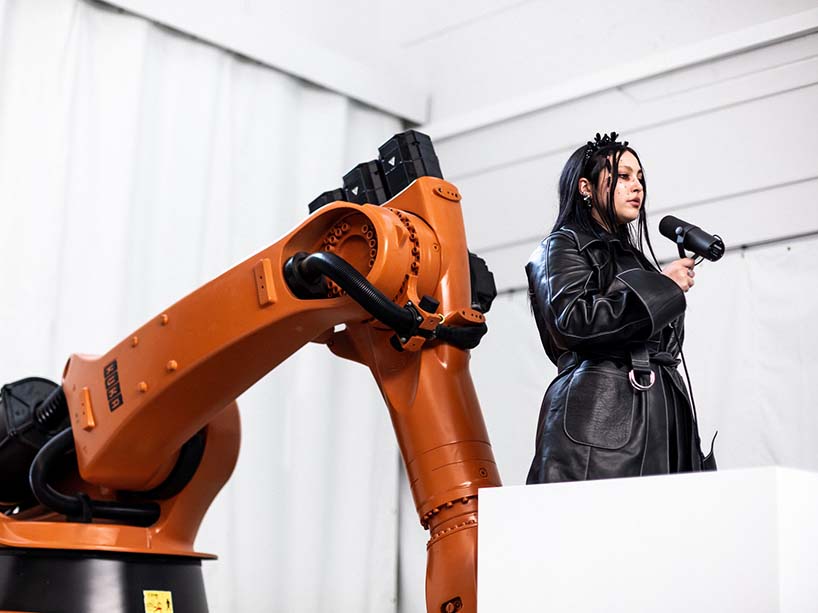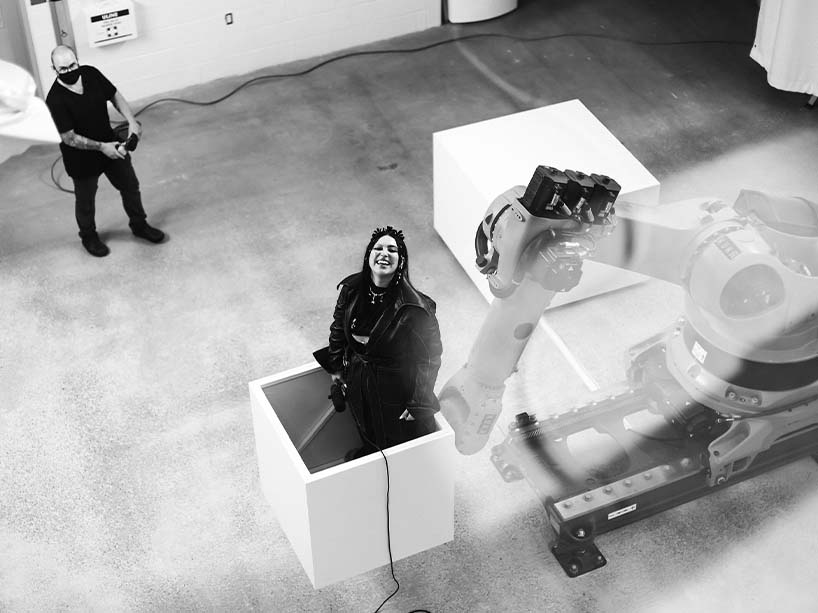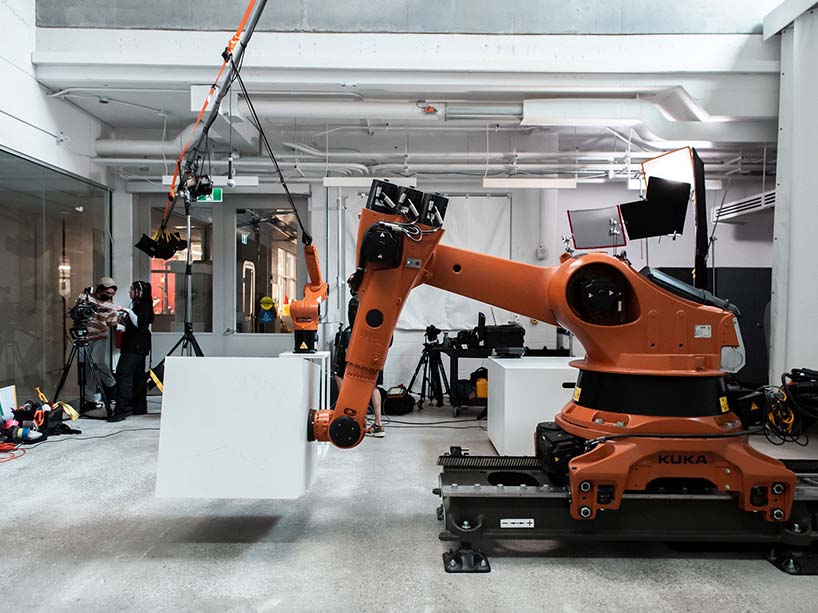Explore the relationship between human and robot in this new performance art series
“If I were to give an elevator pitch for the Design + Technology LAB, it’s that the Lab operates at the intersection of design, fine art and technology,” says Jonathon Anderson, director of the lab, housed at The Creative School, and professor in Ryerson’s School of Interior Design.
And this fall, the Lab helped Camille Poliquin, the Montreal-based musician behind KROY (external link) , produce a seven-video series (external link) exploring the relationship between humans and robots that will launch at the PHI Centre in Montreal January 21-30 (external link) .
The music video shoot
Poliquin reached out to Anderson through her connection with the Future of Live Entertainment (FOL!E) lab at the university’s The Creative School. She needed a collaborator and some technical expertise to help her make her vision a reality for her latest music video.
To see her vision through for ANIMACHINA - animisme et némésis, she wanted to interact directly with the Lab’s robot.
“At the Lab, we had already been talking about robots in live performances, so it felt like a natural progression to work with KROY because of her interest in robot-human interaction,” says Anderson. “We talked about what was possible and how we could push the limits and start to rethink things. We wanted to think of the robot as both a character and as stagecraft.”
Anderson and his small team at the Lab had many things to consider, including feasibility, kinematics and above all, safety. “It was really a brainstorming exercise. Then, KROY came on campus and we did a series of three workshops where we started to test some of these ideas out.”
“KROY brought us a vision from the standpoint of her music,” says Anderson. “After that, it was a year and a half of constant conversation, where we not only tested things physically, but were utilizing software and robot safety standards from Ontario to validate what it was that we were doing. We looked at things like: can we simulate this into the computer and do I start to see any anomalies or moments where there are potential problems.”
The result is an impressive feat: the video series utilizes the lab’s KUKA robots (an industrial robot frequently used in factories to automate certain processes) to interact with KROY and tell a story. The robot plays the keyboard, mixes KROY's voice by controlling various mixers and even lifts her up in space for a duet.
“I wanted to explore the boundaries between human and robotic movement, and the differences between musical and robotic parameters,” says Poliquin. “For example, in a performance with my keyboard, the robot is playing a simplified version of one of my songs, but the distance between the notes was calculated in metres per second. In music, everything is measured in beats per minute, which means that the way the robot is playing the keyboard to my song is very unnatural.”

Montreal-based musician KROY launches her performance art video series, ANIMACHINA: animisme et nemesis, that explores the relationship between humans and robots with the help of The Creative School’s Design + Technology LAB. Photo by Anthony Tuccitto.
“I felt such immense pride that the lab wanted to collaborate with me on this project,” says Poliquin. “My ideas were structured like dreams in my head, with no clue what would actually be possible or not. I found the perfect partners at the Lab -- they’re a team with an artistic vision and capacities beyond my understanding.”
“I found an incredibly important creative partner in Jonathon Anderson. I feel honoured to have had the opportunity to work with such an impressive mind. I also feel like my desire to work with teams outside of the musical world has exponentially grown. I encourage artists to reach out to other disciplines to collaborate.”
The research behind the robots
Working with KROY was of interest to Anderson because it aligned with his own research.
“My research is about how industrial robots and computer numeric control (CNC) technology influence the design and making process. I look at how these industrial machines can be used for bespoke or creative production.”
Anderson says that there are currently only a few people – two or three – within Canada using these robots in this way.
“These industrial robots weren’t intended for robot-human collaboration,” he says. “Ours came from a BMW factory, where all it did was weld the door frame all day long. But this tool can be adapted to a variety of projects, whereas another tool like a laser cutter for example, can't become something else. This robotic arm could be a laser cutter one day and it can be a spindle to carve three-dimensional forms the next day. Having that flexibility allows you to start to push the limits in terms of how they're used and what they're used for.”

Photo by Anthony Tuccitto.
Beyond the robots
The Lab, embedded within The Creative School, is a massive technology-based workshop that leverages digital fabrication tools and technology to facilitate creative processes. Set up to support students and researchers in their own work, the Lab did some major pivoting over lockdowns to fabricate face shields, acrylic dividers and fulfil job requests from students and researchers for their individual projects.
The lab has many more things with which students and researchers can get creative. “The ethos of our lab is that we provide hands-on training with all of the technology,” says Anderson. “And the idea is that by providing that training, we're ultimately empowering students and the faculty members to utilize the equipment in their own ways.”

Photo by Anthony Tuccitto.
When the pandemic hit and on-campus spaces closed, the Lab had to rethink their processes. It had only opened three months before the campus-wide closures in 2020. “We decided that we would provide some video tutorials for our community members to get some basic understanding of what the machine is and what it can do,” says Anderson. The team then posted those to their website and hosted virtual office hours to talk through students’ projects with them.
Most importantly, they switched to a service bureau model, receiving students’ project briefs and producing the material on their behalf. “I didn't want to see millions of dollars of equipment not be utilized for an indefinite or indeterminate amount of time. So we quickly pivoted to ensure that the students still had access to this high level of technology and were able to be thought leaders as they graduate from the university.”
The Lab is now starting to invite students and researchers back into the physical space but it will maintain a part of the service bureau model as its success has been beyond what anyone has expected.
For more information on the launch of the video series and how to see it, visit the PHI Centre’s website (external link) . Visit this page (external link) every day of the installation between 4 p.m. and 12 a.m. EST for a special live stream featuring the robot.